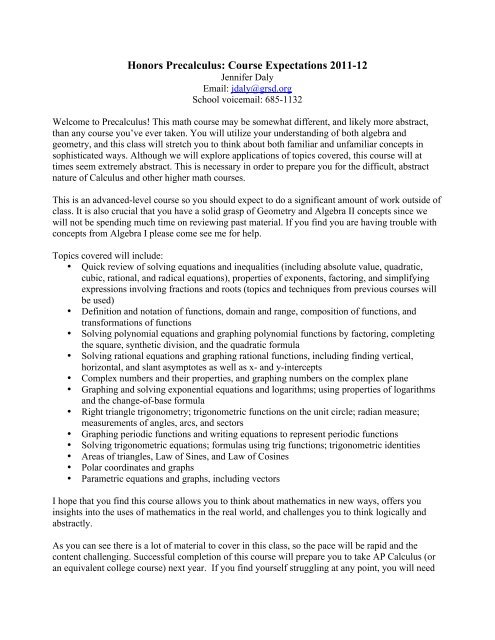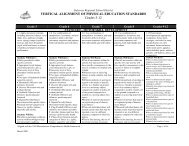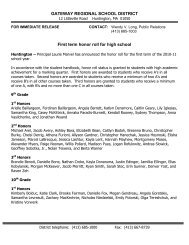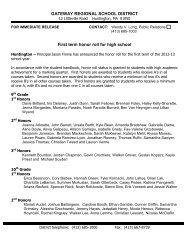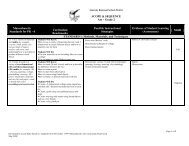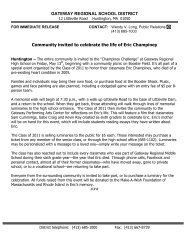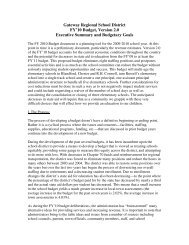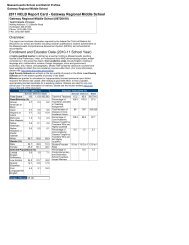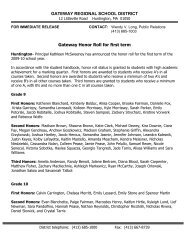Honors Precalculus: Course Expectations 2011-12
Honors Precalculus: Course Expectations 2011-12
Honors Precalculus: Course Expectations 2011-12
Create successful ePaper yourself
Turn your PDF publications into a flip-book with our unique Google optimized e-Paper software.
<strong>Honors</strong> <strong>Precalculus</strong>: <strong>Course</strong> <strong>Expectations</strong> <strong>2011</strong>-<strong>12</strong><br />
Jennifer Daly<br />
Email: jdaly@grsd.org<br />
School voicemail: 685-1132<br />
Welcome to <strong>Precalculus</strong>! This math course may be somewhat different, and likely more abstract,<br />
than any course you’ve ever taken. You will utilize your understanding of both algebra and<br />
geometry, and this class will stretch you to think about both familiar and unfamiliar concepts in<br />
sophisticated ways. Although we will explore applications of topics covered, this course will at<br />
times seem extremely abstract. This is necessary in order to prepare you for the difficult, abstract<br />
nature of Calculus and other higher math courses.<br />
This is an advanced-level course so you should expect to do a significant amount of work outside of<br />
class. It is also crucial that you have a solid grasp of Geometry and Algebra II concepts since we<br />
will not be spending much time on reviewing past material. If you find you are having trouble with<br />
concepts from Algebra I please come see me for help.<br />
Topics covered will include:<br />
• Quick review of solving equations and inequalities (including absolute value, quadratic,<br />
cubic, rational, and radical equations), properties of exponents, factoring, and simplifying<br />
expressions involving fractions and roots (topics and techniques from previous courses will<br />
be used)<br />
• Definition and notation of functions, domain and range, composition of functions, and<br />
transformations of functions<br />
• Solving polynomial equations and graphing polynomial functions by factoring, completing<br />
the square, synthetic division, and the quadratic formula<br />
• Solving rational equations and graphing rational functions, including finding vertical,<br />
horizontal, and slant asymptotes as well as x- and y-intercepts<br />
• Complex numbers and their properties, and graphing numbers on the complex plane<br />
• Graphing and solving exponential equations and logarithms; using properties of logarithms<br />
and the change-of-base formula<br />
• Right triangle trigonometry; trigonometric functions on the unit circle; radian measure;<br />
measurements of angles, arcs, and sectors<br />
• Graphing periodic functions and writing equations to represent periodic functions<br />
• Solving trigonometric equations; formulas using trig functions; trigonometric identities<br />
• Areas of triangles, Law of Sines, and Law of Cosines<br />
• Polar coordinates and graphs<br />
• Parametric equations and graphs, including vectors<br />
I hope that you find this course allows you to think about mathematics in new ways, offers you<br />
insights into the uses of mathematics in the real world, and challenges you to think logically and<br />
abstractly.<br />
As you can see there is a lot of material to cover in this class, so the pace will be rapid and the<br />
content challenging. Successful completion of this course will prepare you to take AP Calculus (or<br />
an equivalent college course) next year. If you find yourself struggling at any point, you will need
to spend time with me outside of class. Failure to promptly resolve these difficulties may make it<br />
impossible to pass the course; do NOT allow yourself to fall a week (or more) behind.<br />
So if you find yourself struggling or would like some extra practice with the concepts, I am<br />
available almost every day after school in Room 204 until 4:00. I do not mind if you stop by, but to<br />
ensure that I will be there, please let me know if you will be staying after school.<br />
Class Structure<br />
In general, class time will consist of interactive lectures (with note taking by students), individual or<br />
group work, class discussions, and demonstrations of concepts using the available technology.<br />
Students will spend a good amount of class time working individually or collaboratively on<br />
problems and are expected to use class time constructively. Please be willing to keep trying, even<br />
when you feel frustrated: giving up is not an option!<br />
In order to be successful in this class, there are several rules you should be aware of:<br />
1. You are expected to bring an organized notebook/binder, a scientific calculator or graphing<br />
calculator and a writing utensil to class every day. (If this is a problem, please let me know.) If you<br />
plan on purchasing a graphing calculator, the math department recommends the TI-83, TI-84, or TI-<br />
89 versions. I would also suggest you have a folder or a three-ring binder, since you will receive<br />
many handouts.<br />
2. Be in your seat and ready to work when the bell rings. At times I will have warm-up problems to<br />
complete while I am checking in the homework. These problems are not optional and you are<br />
expected to work on those problems independently and without talking.<br />
3. Please take care of your personal needs (i.e. bathroom, locker) before class begins. Please bring a<br />
pass if you arrive late to class; unexcused tardiness will earn you disciplinary consequences and will<br />
be reflected in your class participation grade. Also, please do not plan to leave the room during the<br />
first few minutes of class or while I am explaining something at the board.<br />
4. You are expected to be respectful of others at all times. Any remarks or actions that I view as<br />
disrespectful will affect your class participation grade, and will result in disciplinary consequences.<br />
5. If you are absent, it is your responsibility to obtain the assignments and notes, and to arrange a<br />
date to make up any tests/quizzes that you missed. Please see me at the end of the class or at the<br />
end of the school day to get your work. Also, you are still responsible for the work that was due the<br />
day(s) you were absent.<br />
6. Plagiarism, or academic dishonesty, is a serious issue. Plagiarism includes copying another<br />
student’s assignment and obtaining (or attempting to obtain) answers on a quiz or test. While I do<br />
encourage you to collaborate with other students on homework assignments and class work, do not<br />
just give the answer to or receive answers/work from another person. A student who plagiarizes<br />
will receive no credit for his work and both parents and an administrator will be notified.
Grading Policy<br />
• Assessments (Tests and Quizzes): The point value for the assessments varies from 10 to<br />
100 points each. (Note: these point values are estimated and subject to change.) Tests<br />
will be announced well in advance, but quizzes may be given with no notice.<br />
• Assignments/Projects: Throughout this course, I will have you complete graded<br />
problems and projects to demonstrate your knowledge of the concepts being discussed.<br />
These assignments will require you to explain the steps you took in solving a problem<br />
and the point value for each will depend upon how many questions I assign or how big<br />
the project is.<br />
• Homework: Homework is a crucial component to this course and will be assigned daily.<br />
You can expect to have homework over the weekends and possibly on<br />
vacations/holidays. Each homework assignment is worth 2 points. You will receive full<br />
credit for a completed assignment with all work shown. You will receive 1 point for<br />
homework that is partially completed with work shown. You will receive 0 points for<br />
homework that is forgotten, no work shown, or incomplete.<br />
• Participation: All students are expected to explain their work on the board, to participate<br />
in class discussions, and to participate in group work. The GRSD student accountability<br />
rubric will be used to determine the student’s participation grade which is graded on a<br />
weekly basis.<br />
Videos<br />
Occasionally, a video may be shown during class time. Some titles are: A Beautiful Mind,<br />
Stand and Deliver, October Sky, or episodes of Numb3rs.
Please sign and return by September 8, <strong>2011</strong>:<br />
I have read and understand the classroom expectations for Ms. Daly’s <strong>Honors</strong> <strong>Precalculus</strong> class.<br />
Student Signature:___________________________________________Date:_______________<br />
Parent/Guardian Signature:_____________________________________Date:______________<br />
Parent/Guardian email address (optional):____________________________________________<br />
Any comments or things I should know:<br />
______________________________________________________________________________<br />
______________________________________________________________________________<br />
______________________________________________________________________________<br />
______________________________________________________________________________<br />
______________________________________________________________________________<br />
______________________________________________________________________________<br />
______________________________________________________________________________<br />
______________________________________________________________________________
Syllabus: <strong>Honors</strong> <strong>Precalculus</strong><br />
Unite 1: Functions<br />
Part I: Using Functions and Function Notation<br />
• Differentiate between relations and functions<br />
• Evaluate functions for specific values<br />
• Operations with functions<br />
• Composition of functions<br />
• Domain and range<br />
• Finding intercepts<br />
• Transformations of functions<br />
• Inverse of functions<br />
• Using the graphing calculator to find intervals (increasing/decreasing, concave up/down)<br />
Part II: Quadratic and Higher-Degree Polynomials<br />
• Completing the square, using the quadratic formula<br />
• Equations of parabolas (vertex and standard form)<br />
• Finding max/min values (vertex or graphing calculator)<br />
• Word problems involving polynomials<br />
• Complex numbers and roots<br />
• Systems of polynomial equations<br />
Part III: Rational Functions and Partial Fractions<br />
• Sketching rational functions y = 1/x<br />
• Finding domain/vertical asymptotes<br />
• Finding values and intercepts<br />
• Finding horizontal asymptotes and slant asymptotes<br />
• Solving rational equations and inequalities with or without calculators<br />
• Partial fractions<br />
Part IV: Exponential and Logarithmic Functions<br />
• Graphing exponential functions<br />
• Calculating compound interest<br />
• Evaluating logarithms<br />
• Converting between exponential and logarithmic equations<br />
• Sketching logarithmic functions<br />
• Finding inverse of a logarithm or exponential curve<br />
• Applying properties of logs<br />
• “Change of base” formula<br />
• Word problems involving exponential and logarithmic functions<br />
Unit 2: Trigonometry<br />
Part I: Evaluating Trigonometric Rations<br />
• Converting between radians and degrees, including degrees/minutes/seconds<br />
• Finding arc length<br />
• Drawing angles on unit circle<br />
• Finding reference angles
• Evaluating trigonometric ratios for angles in radian measure; review of special right<br />
triangles<br />
• Finding lengths of arcs and areas of sectors<br />
Part II: Sketching Trigonometric Functions<br />
• Sketching the six trigonometric functions<br />
• Identifying amplitude, period, phase shift, frequency, and vertical shift for sinusoidal graphs<br />
• Modeling real-life situations involving sinusoidal functions<br />
Part III: Trigonometric Identitites<br />
• Deriving and using Pythagorean identities, reciprocal identities, and negative angle identities<br />
• Using the sum, difference, and double angle identities<br />
Part IV: Solving Other Triangles; using vectors (2 weeks)<br />
• Area of triangles (using trig)<br />
• Using the Law of Sines<br />
• Using the Law of Cosines<br />
Unit 3: Conic, Parametric, Polar, and Vector Functions<br />
Part I: Conic Sections<br />
• Equations of circles (center and radius)<br />
• Converting into standard form<br />
• Drawing and writing equations for ellipses<br />
• Drawing and writing equations for hyperbolas<br />
• Parabolas as conic sections<br />
• Systems of conic sections<br />
Part II: Vectors<br />
• Graphing vectors<br />
• Adding, subtracting, and scalar multiplication of vectors<br />
• Representing vectors in polar and trigonometric forms<br />
Part III: Polar Equations and Graphs<br />
• Polar equations and their graphs<br />
• Polar equations of conic sections (circles, ellipses, and hyperbolas)<br />
Part IV: Parametric Equations and Graphs (1 week)<br />
• Graphs of parametric equations<br />
Unit 4: Sequences and Series<br />
• Sequences and summation notation<br />
• Arithmetic and geometric sequences<br />
• Limits of sequences<br />
• Introduction to series and limits of series


